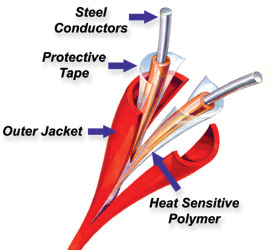An option to multiple heat detectors: Linear Heat Sensing Cable
 Linear heat sensing cables offer a cost-effective alternative to the conventional fixed-temperature heat detectors that are a part of many commercial fire alarm systems. Linear heat sensors (LHS) are used to provide early detection of overheating or fire conditions in manufacturing plants, warehouses, processing facilities, waste recycling plants, industrial equipment, vehicles and other locations. Such sensors are ideally suited for harsh environmental conditions and in situations where it is too difficult or expensive to install a conventional heat detector. One of the biggest advantages of an LHS is that it can be installed in direct contact with or at the exact point of a fire or overheating risk.
Linear heat sensing cables offer a cost-effective alternative to the conventional fixed-temperature heat detectors that are a part of many commercial fire alarm systems. Linear heat sensors (LHS) are used to provide early detection of overheating or fire conditions in manufacturing plants, warehouses, processing facilities, waste recycling plants, industrial equipment, vehicles and other locations. Such sensors are ideally suited for harsh environmental conditions and in situations where it is too difficult or expensive to install a conventional heat detector. One of the biggest advantages of an LHS is that it can be installed in direct contact with or at the exact point of a fire or overheating risk.
A linear heat sensor (LHS) comprises of a small diameter cable featuring a pair of tightly twisted tri-metallic conductors insulated with a highly heat-sensitive polymer outer layer. The insulation is designed to break down at a specific fixed temperature causing the pair of twisted metallic wires to come into contact with each other and triggering the industrial fire alarm in the process. Linear heat sensors with different temperature ratings can be connected together within a detection area to monitor equipment and components with different ambient temperatures. A LHS can be used to monitor ambient temperatures ranging from -40 degrees Fahrenheit to +392 F.
Many of the linear heat sensing cables used for alarm monitoring purposes in Houston and elsewhere are fixed temperature sensors. In other words, they are rated to initiate an alarm at specific ambient temperatures. For instance, in an LHS rated for 155 degrees Fahrenheit, the heat-sensitive insulation covering the twisted metallic conductors will melt once that temperature is reached, thereby triggering an alarm. Some linear heat sensors are analog by design. They are designed to sense temperature variations by continuously monitoring the electrical resistance within different segments of the cable. When the temperature rises beyond a specified point, the resistance in the wire is lowered causing an alarm to be triggered.
Sources:
http://www.vimpex.co.uk/english/signaline-linear-heat-detection-system.htm
http://www.lineardetection.com/faq.htm#q1

